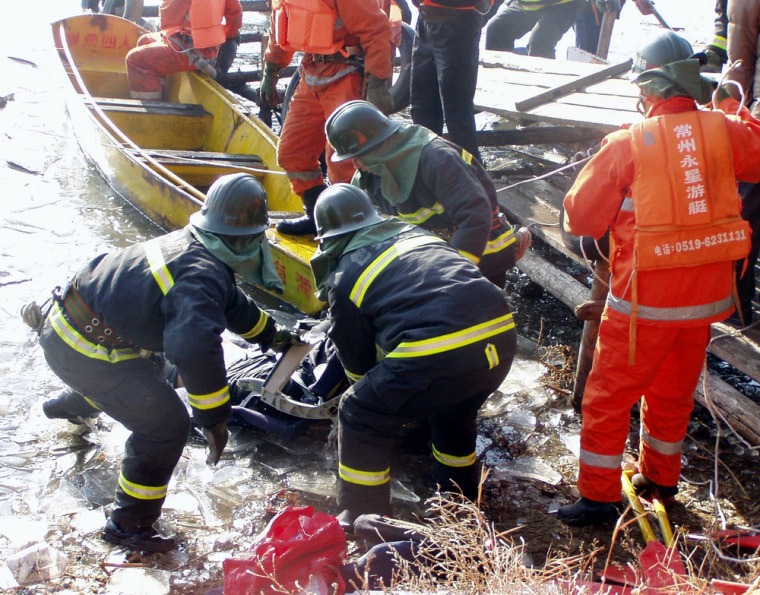Investigators have found no evidence of terrorism or other “man-made destruction” in the crash of a Chinese airliner that exploded after takeoff and plunged into an ice-covered lake, killing 54 people, according to official reports Monday.
Divers searched the lake for the “black box” flight data recorders of the Bombardier CRJ-200 belonging to China Eastern Airlines. The plane went down Sunday after taking off from the northern city of Baotou on a flight to Shanghai.
Investigators sent from Beijing had not determined the cause of the crash but found no evidence of terrorism, state television said. The official Xinhua News Agency said they found no sign of other “man-made destruction.”
The government grounded all CJR-200s in China following the crash, the country’s deadliest airline disaster in two years.
Software CEO killed
Among the dead was the president of one of China’s biggest software companies, news reports said.
Witnesses said the Canadian-built plane began to shake after takeoff, Xinhua said. They heard a loud bang and “the plane broke into flaming fragments,” then hit the lake, spreading burning oil across the icy surface, the report said.
All 47 passengers and six crew members aboard were killed, as well as one person on the ground. One passenger was Indonesian and the rest were Chinese. Rescue workers had to break through the ice of the lake to retrieve the bodies, Xinhua said.
The dead included Chen Suyang, president of Fudan Forward S&T Co., Ltd., software maker affiliated with elite Fudan University in Shanghai, news reports said. An employee of the company who wouldn’t give his name confirmed that Chen was on the flight.
Efforts to improve safety
The disaster marred intensive official efforts to improve China’s air safety following a string of deadly crashes in the 1990s.
Shanghai-based China Eastern planned to fly relatives of the dead to Baotou on Monday, airline official Li Jiang said. Li said he had no additional information about the crash or the airline’s response.
The airline referred other questions to a China Eastern subsidiary that operated the flight. Phone calls to the subsidiary weren’t answered.
Reporters in Shanghai saw about 50 relatives, many of them elderly and some weeping, board buses to the airport. They were accompanied by dozens of security guards who prevented reporters from speaking to them.
China’s Cabinet dispatched investigators to the crash site, about 330 miles west of the Chinese capital, Xinhua said.
'Fireball' seen over lake
Witnesses told the agency they heard an explosion before the plane hit the ground, and one described seeing “a big fireball” overhead.
The person killed on the ground was an employee of Nanhai Park, where the plane plunged into a lake. Xinhua said a house next to the park was damaged and several boats were scorched.
A witness identified as Ms. Gao was quoted as saying the plane began to shake when it reached the height of a six-story building.
“The plane then shook for four or five seconds and tried to turn around. But suddenly its tail caught fire with a bang. Then heavy smoke and a foul smell engulfed the area,” Gao was quoted as saying.
Wang Yongqiang, who lives near the park, said he saw black smoke billowing from the tail of the plane before it crashed, Xinhua said. It said he heard “a big blast” when the plane was still in the air.
The weather in Baotou was clear and cold — about 25 degrees.
A string of deadly airline crashes in the 1990s prompted the Chinese government to tighten safety measures and upgrade airplanes in the state-owned aviation industry.
The nation’s last major crash was on May 7, 2002, when a China Northern Airlines MD-82 plunged into the sea off the northeastern port city of Dalian, killing 112 people.
Officials blamed the crash on arson by a passenger who had taken out seven life insurance policies.
